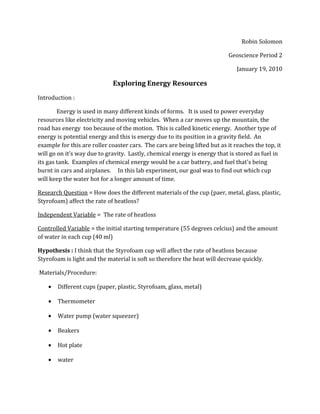
Effects of Cup Materials on Heat Loss Rate
- 1. Robin Solomon Geoscience Period 2 January 19, 2010 Exploring Energy Resources Introduction : Energy is used in many different kinds of forms. It is used to power everyday resources like electricity and moving vehicles. When a car moves up the mountain, the road has energy too because of the motion. This is called kinetic energy. Another type of energy is potential energy and this is energy due to its position in a gravity field. An example for this are roller coaster cars. The cars are being lifted but as it reaches the top, it will go on it’s way due to gravity. Lastly, chemical energy is energy that is stored as fuel in its gas tank. Examples of chemical energy would be a car battery, and fuel that's being burnt in cars and airplanes. In this lab experiment, our goal was to find out which cup will keep the water hot for a longer amount of time. Research Question = How does the different materials of the cup (paer, metal, glass, plastic, Styrofoam) affect the rate of heatloss? Independent Variable = The rate of heatloss Controlled Variable = the initial starting temperature (55 degrees celcius) and the amount of water in each cup (40 ml) Hypothesis : I think that the Styrofoam cup will affect the rate of heatloss because Styrofoam is light and the material is soft so therefore the heat will decrease quickly. Materials/Procedure: • Different cups (paper, plastic, Styrofoam, glass, metal) • Thermometer • Water pump (water squeezer) • Beakers • Hot plate • water
- 2. 1. Boil the water in a beaker and the place the thermometer in until the temperature of the water is 55 degrees celcius. 2. Using the small water pump put equal amounts of water (40 ml) in each cup and record temperature in each cup after 5 minutes Data Processing: Material of cup Temperature after 5 minutes (celcius °) Percent of heat left Percent of heatloss after 5 minutes Paper 36 65.45 34.55 metal 39 70.90 29.10 plastic 45 81.81 18.19 glass 43 78.18 21.82 styrofoam 49 89.09 10.91
- 3. Series 1 = Temperature of water in celcius Series 2 = Percent of Heat Left Series 3 = Percent of heatloss after 5 minutes. Conclusion / Evaluation: In conclusion, my hypothesis was not supported because I thought that the styrofoam cup will contribute to the greatest amount of heatloss. It turned out to be the paper cup that had the large amount of heatloss after 5 minutes. The percentage heatloss after 5 minutes for the paper cup was 34.55 and the material with the lowest percentage of
- 4. heat loss is the Styrofoam cup. The reason for this is because, paper is soft and when warm water is poured in, it will lose heat faster. If it was the metal cup, it would be different because the water will stay warm longer because metal retains heat. Errors and weaknesses that may have affected the lab results is maybe not pouring equal amounts of water in the cups. Also, when pouring the warm water in the paper cup, it was cone shape so it over flowed.
